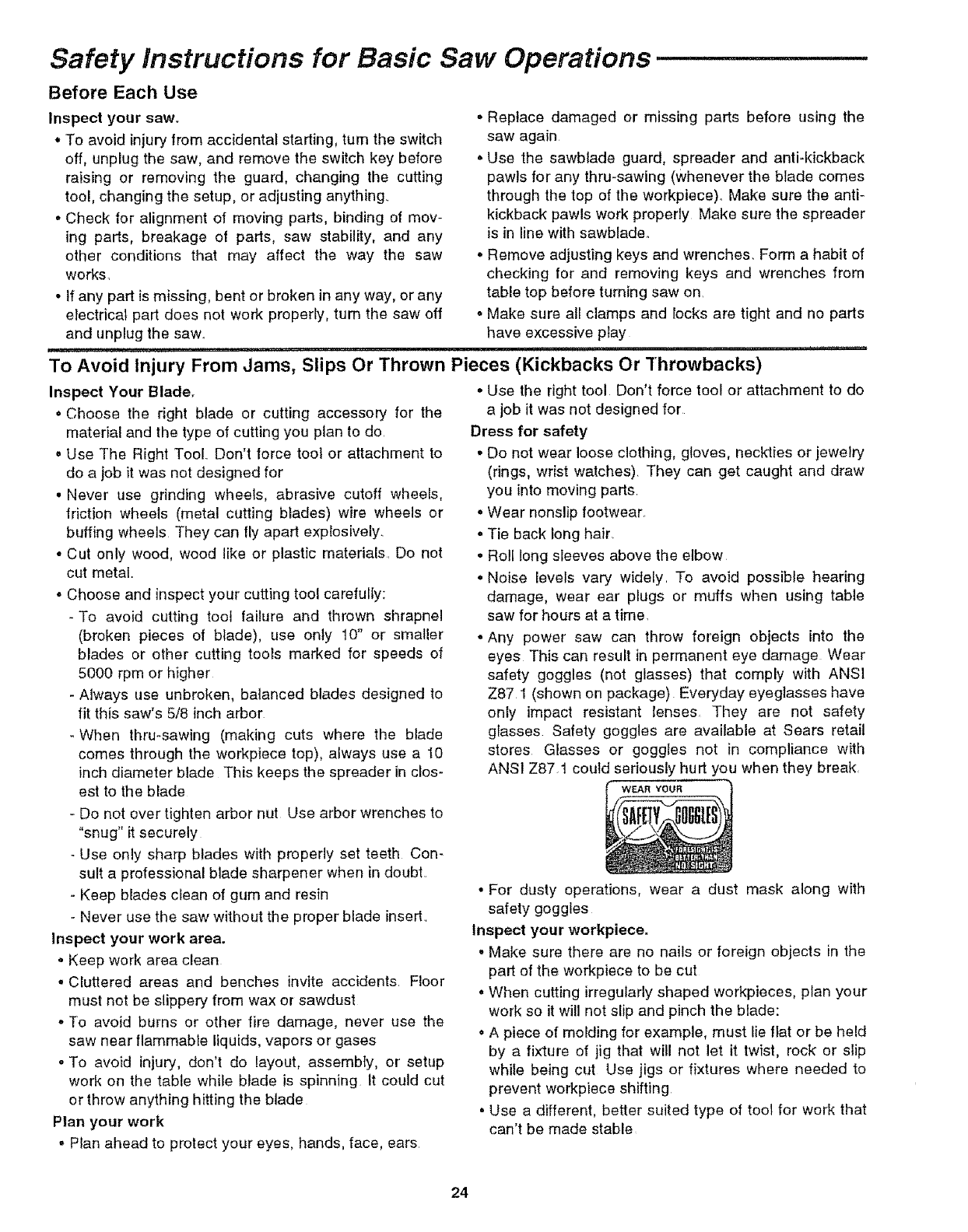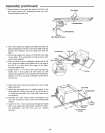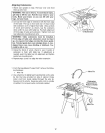
Safety Instructions for Basic Saw Operations ...........
Before Each Use
Inspect your saw.
• To avoid injury from accidental starting, tum the switch
off, unplug the saw, and remove the switch key before
raising or removing the guard, changing the cutting
tool, changing the setup, or adjusting anything,
. Check for alignment of moving parts, binding of mov-
ing parts, breakage of parts, saw stability, and any
other conditions that may affect the way the saw
works.
• If any part is missing, bent or broken in any way, or any
electrical part does not work properly, turn the saw off
and unplug the saw.,
. Replace damaged or missing parts before using the
saw again
. Use the sawblade guard, spreader and anti-kickback
pawls for any thru-sawing (whenever the blade comes
through the top of the workpiece). Make sure the anti-
kickback pawls work properly Make sure the spreader
is in line with sawbladeo
• Remove adjusting keys and wrenches. Form a habit of
checking for and removing keys and wrenches from
table top before turning saw on,
• Make sure all clamps and locks are tight and no parts
have excessive play
....... , , ,,i ,i,,,11111,,,,,,,,,,,,i
To Avoid Injury From Jams, Slips Or Thrown Pieces (Kickbacks Or Throwbacks)
Inspect Your Blade.
• Choose the right blade or cutting accessory for the
material and the type of cutting you plan to do,
=Use The Right Tool, Don't force tool or attachment to
do a job it was not designed for
° Never use grinding wheels, abrasive cutoff wheels,
friction wheels (metal cutting blades) wire wheels or
buffing wheels They can fly apart explosively..
• Cut only wood, wood like or plastic materials, Do not
cut metal,,
• Choose and inspect your cutting tool carefully:
-To avoid cutting tool failure and thrown shrapnel
(broken pieces of bIade), use onty t0" or smaller
blades or other cutting tools marked for speeds of
5000 rpm or higher
- Always use unbroken, balanced blades designed to
fit this saw's 5/8 inch arbor
-When thru-sawing (making cuts where the blade
comes through the workpiece top), always use a I0
inch diameter blade This keeps the spreader in clos-
est to the blade
- Do not over tighten arbor nut Use arbor wrenches to
"snug" it securely
- Use only sharp blades with properly set teeth Con-
sult a professional blade sharpener when in doubt
- Keep blades clean of gum and resin
- Never use the saw without the proper blade insert,
Inspect your work area.
o Keep work area clean
° Cluttered areas and benches invite accidents, Floor
must not be slippery from wax or sawdust
oTo avoid burns or other fire damage, never use the
saw near flammabte liquids,vapors or gases
oTo avoid injury, don't do layout, assembly, or setup
work on the table while blade is spinning tt could cut
or throw anything hitting the blade
Plan your work
° Plan ahead to protect your eyes, hands, face, ears
• Use the right tool Don't force too! or attachment to do
a job it was not designed for
Dress for safety
• Do not wear loose clothing, gloves, neckties or jewelry
(rings, wrist watches). They can get caught and draw
you into moving parts
• Wear nonslip footwear,
° Tie back long hair.
° Roll long sleeves above the elbow
• Noise levels vary widely, To avoid possible hearing
damage, wear ear plugs or muffs when using table
saw for hours at a time.
° Any power saw can throw foreign objects into the
eyes This can result in permanent eye damage Wear
safety goggles (not glasses) that comply with ANSI
Z87 1 (shown on package) Everyday eyeglasses have
only impact resistant lenses They are not safety
glasses Safety goggles are available at Sears retail
stores Glasses or goggles not in compliance with
ANSI Z871 could seriously hurt you when they break,
WEAR YOUR
• For dusty operations, wear a dust mask along with
safety goggles
Inspect your workpiece.
• Make sure there are no nails or foreign objects in the
part of the workpiece to be cut
• When cutting irregularly shaped workpieces, plan your
work so it will not slip and pinch the blade:
. A piece of molding for example, must lie flat or be held
by a fixture of jig that will not let it twist, rock or slip
whiIe being cut Use jigs or fixtures where needed to
prevent workpiece shifting
• Use a different, better suited type of tool for work that
can't be made stable
24


















